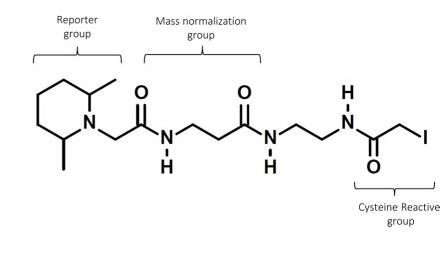TMT-based Quantitative Proteomics Analysis
TMT-based quantitative labeling techniques are precise and widely used, and are frequently used in proteomics research. Creative Proteomics can provide professional TMT-based quantitative proteomics services to facilitate your protein research, while specializing in proteomics research for many years.
What is TMT-based Quantitative Proteomics
TMT, or Tandem Mass Tag, represents a state-of-the-art peptide isotope labeling technique, designed to enable quantitative proteomics studies with a high degree of accuracy and versatility. It has a similar structure and the same principle as iTRAQ tags, and they are both commonly used for labeling proteomics techniques. This innovative method employs 6, 10, or even 16 isotope tags to selectively label the amino groups of peptides, facilitating the concurrent comparison of protein expression levels across multiple samples. TMT-based quantitative proteomics stands as a robust and versatile technique for studying protein expression and dynamics. Its ability to simultaneously analyze multiple samples with high precision makes it an indispensable tool for a wide range of scientific investigations, fostering advancements in fields such as biology, medicine, and drug development.
The Principle of TMT-based Proteomics
TMT tag consists of three components: a reporter group, a balance group, and a reactive group The reactive group is covalently attached to the peptide's amino group, labeling the peptide. The balance group balances the mass difference of the reporter group to keep the equal label weights consistent, which ensures the same labeled m/z of the same peptide. The reporter group reflects the abundance of labeled peptides to quantify protein. In different samples, peptides from the same protein have equal m/z after labeling by TMT reagent, and show the same mass peak in MS1. In MS2, the balance groups are lost neutrally and the reporter groups are released, which produce reporter ions with different masses. According to the abundance of reporter ions, quantitative information about the same peptide between samples can be obtained, and the protein can be quantified after data analysis.

Fig. 1. Structure of TMT tag. (Rauniyar, N., et al., 2014)
Applications of TMT-based Proteomics
It offers a wide variety of valuable applications. Its efficient and accurate analysis is well suited to medicine, biomedicine, agriculture and forestry, animal husbandry, microbiology, and other life science fields. The specific applications include biomarker detection, characterizing diseases, pharmacological efficacy, drug development, crop improvement, meat and milk quality research, microbial pathogenesis and drug resistance research, etc.
Our Service
As a result of its accuracy, good stability, high protein coverage, and wide range of samples, TMT-based proteomics is widely used in many fields related to the life sciences. Creative Proteomics provides high-quality TMT-based quantitative proteomics analysis services. In addition, we also provide iTRAQ-based quantitative proteomics analysis services.

Fig. 2. TMT-based proteomics workflow
Advantages of TMT-based Proteomics
- Labeled in vitro, suitable for a wide range of samples.
- Compare 2-16 samples in parallel, suitable for multi-control group experimental analysis.
- High quantitative stability within the same batch.
- Fast detection and high coverage.
- Integrated with PTMs proteomics to achieve more accurate research on PTMs.
Creative Proteomics provides comprehensive and high-quality proteomics analysis services. If you are interested in TMT-based quantitative proteomics analysis, please contact us for more details.
Reference
- Rauniyar, N.; Yates, J. R. Isobaric labeling-based relative quantification in shotgun proteomics. Jourmal of Proteome Research. 2014, 13(12): 5293-309

